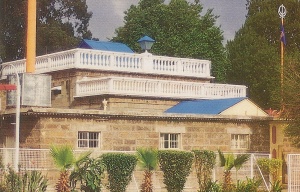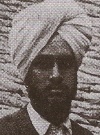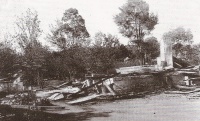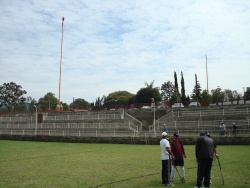Sikh Temple, Nakuru
The history of the Sikhs in Kenya’s Rift Valley and its largest town, Nakuru, is long and distinguished. In the early years many Sikhs and other Indians worked for the railway, the biggest employer, while others were employed by the Government Public Works Department and by the many European farmers who had settled in the areas towns – notably Elburgon, Gilgil, Londiani, Mau, Narok, Molo Naivasha, Thompson’s Falls and Subukia.
When people migrate from one geographical region to another they generally carry with them their cultural and religious values and beliefs. The Nakuru Sikhs were no exception and the fact was recognized in 1903 by the railway authorities who allocated a plot, north of the Nakuru marshalling yards, for the construction of a Gurdwara. As in other cases, most of the early Gurdwara’s in Kenya were built along or near the route of the railway; the location of the most important historic Gurdwara in Kenya - Makindu Gurdwara springs to the mind.
Built, re-built and developed and re-developed since 1918, this Sikh temple (gurudwara) marks a long history of Sikhs in the Rift Valley. Sadly, the local policy of "Africanisation" of post Independence 1963 has ethnically cleansed Sikhs, other south Asians from the rift valley as it has become difficult for the Asians in jobs and trading licenses, etc which has driven them away- these communities are now flourishing in USA, Canada, UK and Australia
A Brief History
The first Nakuru Gurdwara soon became a center for regular diwans (assemblies) and for celebrating Gurpurabs (a festive, special occasion) attended by Sikhs from all over the Rift Valley. Many of the European settlers employed Sikhs from all over the Rift Valley. Many of the European settlers employed Sikhs on their farms and held them in high esteem as hard working people with an all-around ability to tackle any job. Most of the Sikhs had technical backgrounds, and were skilled in saw-milling, mechanical engineering, construction, cabinet and furniture making and were also able to thrive under harsh conditions. Lord Delamere, who farmed vast tracts of land around Njoro and Elementetia, employed a number of Sikhs as syces (grooms) and jockeys for his horses which he raced in Nairobi at the old racecourse (which is now known as Racecourse Road in Nairobi City).
Earlier records indicate that the present plot was acquired on 1st April 1917 and the title registered on 3rd June 1918 in the name of S. Gian Singh, S. Boota Singh, S Wariyam Singh, S. Santa Singh and S. Dausanda Singh as trustees.
As the community grew the need for another larger plot was recognized. In 1925, Sardar Sunder Singh was deputed to be the community’s spokesman to the administrative authorities in negotiations for another larger plot. Sunder Singh was an overseer on Keringet Estate in Molo with a number of Sikh artisans working under him. He spoke English well, fairly uncommon in those days, and a good communicator and the ideal candidate to present the communities case. A plot, where today’s temple stands, was quickly allocated but the grant brought the Sikh community into dispute with the neighbors. However, with the assistance of the then District Commissioner, Mr. Hobley and the indulgence of Sardar Sunder Singh, the matter was promptly resolved to allow the Sikhs to go ahead with developing their temple plot.
The New Gurdwara completed in 3 months
The community stalwarts wasted no time and in about 1926-27 a fully functional and decorated building was completed in three months. The Gurdwara was built with timber framework, clad with corrugated sheets and lined with tounge-and-groove timber and with verandahs on the north, south and west sides and painted throughout.
The new Gurdwara became the central place of worship and was well attended for every Sikh religious function and celebration. As the area developed agriculturally and commercially the membership increased. The plot was fenced with cedar posts and steel wire interleaved with bamboo splits, or ‘droppers’ and the surrounding grounds were improved. An orchard of lemons, guavas, pawpaws, peaches and pomegranates was established; as there were no restrictions on anyone helping themselves it soon became popular, especially among the children on their way to and from school who would pluck lemons and suck them with great relish.
Next it was decided to provide overnight accommodation for members who traveled long distances for Akhand Paaths and who had no relatives or friends in Nakuru with whom they could stay. Rest-house accommodations were built comprising rooms, a kitchen and communal bathroom. Sardar Kishen Singh, the railway shed master in Nakuru, devoted a great deal of time and hard work to this development. In later years the accommodation became popular with foreign backpacking tourists who could not afford expensive hotel accommodation.
In the early days some settlers, who were familiar with Sikh traditions from the time of the British 'Raj" in India, transported their Sikh employees to celebrate their ‘Jor Melas' (a form of celebration) and stayed on to join the 'Langar' (Community meal) after finishing their business in town. The settlers did not escape the worldwide economic depression of the 1930s. Many Sikhs, working on the farms, lost their jobs, for them the Temple rest-house was a boon. A few even camped around the precincts, and showed resilience by planting cabbages, peas, potatoes, beans and maize. S. Pritam Singh Ahluwalia, who had a grain mill at Rongai and was a generous man, regularly supplied wheat floor to the temple although he was himself affected by the depression.
A few of the affected Sikhs opted to return to their villages in India while some decided to stay on. Sardar Inder Singh of Revelco developed a system of rotational employment in his contracting business so that those employed could save enough to travel to India. It was a simple system and it worked: men would be employed for a month and make way for another lot and so on. The idea caught on and employers in Nairobi followed the example and allowed many of those who had lost their jobs through no fault of their own, to earn enough for the fare by ship to India.
1936: Fire destroys the Gurdwara
In 1936 disaster struck: the Temple was gutted by fire and reduced to ashes. Although the cause of the fire was a source of speculation, it was probably accidental. A lantern was always left burning throughout the night and it is likely that it was tipped over and set fire to the furnishings. Whether it was tipped over by thieves or a cat will never be known. The Sikh community tackled the disaster with typical courage and fortitude; part of the rest-houses were modified and decorated to house the Guru Granth Sahib and used as a temporary Temple.
Plans for a new Temple were drawn up by Sardar Ganga Singh, a civil engineer with the railway. The plans formed the basis of the temple as one sees it today and once approved by the Nakuru Municipal Council, construction was soon under way. The local Sikh Community combined with those living in the rest-houses in ‘sewa’ (voluntary work). The laying of the concrete foundations and the floor was completed during a single Sunday. It was an amazing sight to see so many people including children as young as ten years, working so fast and shifting heavy buckets of concrete.
The following Sunday, Sardar Ganga Singh was accorded the honour of laying the foundation stone; afterwards he donated 500/- to the temple fund (in 1936, Shillings 500/= was a large sum). The building stone was carried from Naivasha and chiselled to a fine finish by S. Niranjan Singh, who was nicknamed ‘first class’. The entrance door, designed by S. Inder Singh, was crafted by S. Kartar Singh Mahal who today (1999) lives in Birmingham, England aged 94.
The Gurdwara erected the third time
The building was completed in just five months through voluntary work and a wholehearted contribution by the community and was universally regarded as a truly beautiful building-worthy testimony to the craftsmanship and skills of Nakuru Sikhs. The official opening, after the Akhand path ceremony and other religious ceremonies, was performed by S. Dhanwant Singh, an advocate from Kisumu, and was attended by Sikhs from all over Kenya. The Guest of Honour was the Provincial Commissioner, the Hon. J. G. Hamilton Ross, who was generous in his praise for the Sikh Community in erecting such a fine building in a matter of months and warmly congratulated them.
In early thirties enthusiastic Sikhs working for Railways purchased a timber built structure comprising of several houses, contributing from their meager resources, dismantled it and rebuilt opposite main temple building which till today accommodating several families, sometimes is referred to as the 'Green House'.
The contribution by one remarkable man over many years of the Nakuru Sikh Temple's development must not be forgotten. Bhagat Moolraj, a trader from Elmenteita was appointed President of the temple in 1928. He believed in Sikhism and had adopted its teachings and faith. He devoted considerable energy and commitment to the temple’s affairs and was a sobering influence in the community. After 22 years of dedicated service, he voluntarily relinquished his post as President to make way for others to serve.
Tranquilly returns to the Gurdwara Committee
Following Bhagat Moolraj’s resignation, Sardar Hazara Singh, a chief Inspector of Police, was elected as President. He was followed by S. Satwant Singh of Rivelco whose tenure was marked by the restoration of peace and tranquillity, which was continued under S. Narwair Singh, a Nakuru furniture maker. A stalwart of the Temple was Sardar Santokh Singh, who served as regular bhandari (he who says grace) for several years now aged 98 and living in Nakuru. And in fact his younger son S.Mohinder Singh Rehal continued in the footsteps of his father and served as a bhandari for several years before he was honoured to the Chairmanship of the Temple.
During Sardar Satwant Singh's term of office a start was made in founding a Sikh School for Girls. A piece of land having been acquired under the auspices of Sikh Temple Nakuru, the building came up within a short period. Messrs. Mehar Singh Bros, building contractors performed the religious opening ceremony on 12th June 1960 with the then Rift Valley Provincial Educational Officer Mr, G. G. Knight officially opening the school on 22nd October 1960.
S. Dharam Singh Lall led the School Board in managing its affairs. With the success and increasing demand, a Secondary wing was started with the foundation stone laid by the family of Late S. Bhagat Singh of M.O.W. followed by donation of further classes by Coronation Builders of Nairobi. The ever growing student population made it necessary to move the Primary School to another piece of land allocated by the Municipal Council of Nakuru. Fourteen classrooms were built by the Community from their own financial resources.
Today these schools are named Harambee Khalsa Primary School and Khalsa Secondary School, in keeping with the changes that took place from time to time. More recently a double storey block has been added to the Secondary School and plans for commencing the London G. C. E. classes are at an advanced stage. Dedicated members of the Community headed the School Board after S. Dharam S. Lall, S. Bhagwant S. Jassal, S. Pyara S, Ghata-aura, S. Jagir S. Jutley, S, Harbhajan S. Gill, S. Narinder S. Ghata-aura, S. Bhagwant S. Tung served as Managers. S. Gurbux S. Bhogal is the current Chairman of the Board and leads the enthusiasm of its keen and dedicated members.
History of the Gurdwara committee
There is a long history of intrigue within Sikh Communities, and the Nakuru Sikhs were no exception. S. Tika Singh, a local watchmaker was for several years in the limelight as Secretary and President, S. Narwar Singh Panesar, S. Naurang Singh, S, Sadhu Singh, S. Tika Singh, S. Narinder S. Gill followed until after independence the status of all Presidents of institutions and clubs etc., except the President of Kenya was changed to Chairman. In 1963 S. Niranjan Singh Virdee took over from S, Satwant Singh, who after serving for a year decided to relinquish his position in favour of S, Karam Singh Panesar, a Police Inspector, who handed over to S. Jagjit Singh Bassan, the Vice Chairman due to his transfer from Nakuru and was unanimously confirmed by Saadh Sangat as Chairman and later re-elected to serve the Community for several years until his sad demise at the end of 1974.
To fill the vacant position, S. Sulakhan Singh Gill who was known as 'Jathedar' due to his dedicated service not only in the langar' but as renowned 'Akhand Paathi' was elected unanimously as Chairman in early 1975, the position he occupied till mid April 1981 until his departure to USA for permanent settlement. S. Didar Singh Bhangu, who then took over and steered the temple affairs for some years with admirable skill and diplomacy.
Mr. Rattan Singh kandola who was a long time serving Vice chairman opted to stay as such with s. Didar Singh Bhangu, although he could have been a unanimous choice for the position of Chairman but for his sad demise in 1982.
Mr. Kehar Singh Dewgun, a long serving member on the Managing Committee who filled the position as Vice Chairman was later a popular choice for chairmanship after the retirement of Mr. D.S.Bhangu in July 1987. S. Narwar Singh Bhogal another senior member on the Committee who also served as an Auditor for many years took over from S. Kehar Singh Dewgun and served the Community with great zeal and enthusiasm. It was during his tenure that the purchase of adjacent plots commenced providing abundant acreage to the community for future developments. S. Mohinder S. Rehal as mentioned earlier then took over until January 1999 when S. Narinder Singh Kandola was unanimously elected as the chairman and became perhaps the youngest person to do so. His tenure is blessed with the 300th Anniversary of the Khalsa Panth, which ia a rare and distinct honor.
The role of S. Gurnam Singh Mankoo as a Building Supervisor is also acknowledged with gratitude and so is that of S. Jasjeet Singh Heer in a similar capacity for rendering commendable service to the community. Sardar Seta! Singh Panesar is worthy mention for his invaluable service of the improvements of and image of the Temple. Sardar Gurnam Singh of Dalgity has left a lasting impression of his sewa as Bhandari for 'his' prashad set the mouths to water even up to this day. S. Malkit Singh Bansal is currently the Bhandari and carries out his duties with great diligence.
The Bedi brothers, S. Karnail Singh Bedi and Jarnail Singh Bedi have for several years rendered an immaculate and useful service of providing turban and hair fixer to the community amongst other recognised sewas, truly following the selfless devotion to the Shrine of their. undaunting mother, Mrs Chand Kaur Bedi, S. Sarup Singh Sahans and S. Malvinder Singh Sahans also rendered useful service to Sikh Temple Nakuru and its institutions.
Social Hall built
During the time of Sardar Naurang Singh and Sardar Narinder Singh Calay it became evident that improvements were needed for the distribution of langar after celebrations. The Langar used to be served on old newspaper with the congregation squatting on the Temple floor. Once again Sewa was employed and a fine social hall, the Nanak hall, was built through self-help. Today it is the social heart of the Temple, and weddings, and other function are frequently held there.
A major Temple landmark is the Nishan Sahib - a 60 foot (18 metre) high column, constructed of tapering sheet steel cylinders (see picture to left). It was pieced together with rivets, on site, with purpose-made jigs. It is a magnificent example of craftsmanship at its finest and its erection was another splendid feat accomplished without lifting gear, other than strategically positioned guy ropes, and was hoisted manually in place amid the recitation of Guru’s hymns. The operation was watched from a distance by the Nakuru Town Engineer, Mr. A. Crates and the Town Clerk, Major A, A. Lawrie, both of whom had grave doubts over its success. They felt that the immensely tall structure was bound to collapse and be a danger to all present. However, by Satguru's grace all went well and the officials were well pleased although, at the same time, amazed! A light is fitted at the top with the Khanda Kirpan, the Sikh emblem, and the ceremonial cladding of the pole with saffron cloth, after the cloth is bathed in milky water, is a spectacular event done by Sikh devotees who have no fear of heights.
Recently in 2006, a new Nishan Sahib was installed in the parking lot of the Gurdwara Sahib (see picture to right). This Nishan Sahib is surrounded by a fountain and is desgined to be brought down and parallel to the ground so the Sangat can partake in sewa during Vaisakhi. The Nishan Sahib is also illuminated with orange lights at night and is visible from many points of Nakuru town.
Values contribution by the Sikh ladies
It would be unforgivable if the role of Sikh ladies in the affairs of the Temple was not acknowledged. Mrs. Moolraj, Mrs. Tej Kaur of Rivelco, Mrs. Pritam Kaur Sahans, Mrs. Chand Kaur Bedi, Mrs. Harbans Kaur, Mrs. Swaran Kaor Bhogal, Mrs. Satwant Kaur Marwa, Mrs. SwaranKaur Sian, Mrs Tej Kaur Johal, Mrs. Rajinder Kaur Kondola played a prominent selfless role in the welfare of the Temple. Mrs. Ravinder Kaur Bhangu too made a lasting impact on the ladies for her guidance during the intricacies and tier role of a great ‘sakhee’ teller amongst them proved to be very popular. To Mrs. Harbans Kaur goes the credit of teaching children Gurmukhi and shabads and also to play harmonium under difficult circumstances.
This role which prominently featured in the lives of several Sikh children was continued in the recent past by Mrs, Mohinder Kaur Dhillon, Mrs. Surinder Kaur Ghata-aura, Mrs. Surinder Kaur Tung, Mrs. Sukhdev Kaur Gill and lately by Mrs. Diljit kaur Bhogal, Mrs. Harbans Kaur kandola served as the Chairperson of the ladies ‘Istri sabha’ for 14 years with the Late Mrs.Surjit Kaur Sehmbhi as the Vice-chairperson until her death in1994. Mrs Charanjit Kaor Deogan's service as the Secretary for several years cannot escape without recognition. Mrs. Harbhajan Kaur Bhogal is currently at the helm of the activities, with Mrs.Surjit Kaur Rajbans as her assistant, Mrs Surinder Kaur Bedi and Mrs.Hardev Kaur Dhanoa carry the important role of Secretary and Treasurer respectively. Mrs Avtar Kaur Kondola, Mrs Mohinder Kaur Lottay and Mrs Balbir Kaur Bansal together with other ladies continue their sewa with utmost devotion.
Through the years many sectors of the Sikh Community have devoted time and money,contributed goods in kind and faith to the development of the Nakuru Temple, Deserving of special mention, among so many, are Settlers Engineering for providing and installing a steam boiler; the Bhogals for the attractive landscaping of lawns and gardens around the Temple; Sardar Karnail Singh Bedi who served as Treasurer for several years and more recently, Sardar Jagir Singh who as secretary has streamlined various aspects of Sikh traditions.
His directory of Sikhs in the Rift Valley and Nakuru and his monthly newsletter are valuable contributions. A great many notable Sikhs have contributed to the development over so many years, and it is not possible to mention each and every one. However, especially noteworthy for guidance and support were stalwarts such as Sardar Kishen Singh Contractor, Sardar Niranjan Singh Bhogal, Sardar Amolak Singh Punni, Sardar Shanker Singh Sian. Sardar Jwala Singh Chal, Sardar Gurmeet Singh Kondola, Sardar Channan Singh Ghat-aura, Sardar Nasib Singh Flora, Sardar Kapur Singh Sandhu have been notable Trustees of the Temple.
The Gurdwara was the centre of activity for the Sikhs
A famous 'strong man' in the days when athletic contests and martial arts featured as important events, was Sardar Sojan Singh. He was able to prevent a four- cylinder Chevrolet from moving by leaning on the front mudguard and grasping one of the front wheel's wooden spokes, As the car turned on the power the rear wheels churned up clouds of dust and the car remained stationary. Sardar Harnam Singh, known as 'Shell' because he worked for Shell Oil Company, displayed his skills on a motor bike, He would enter the ground at high speed, standing on the seat and snake high-speed turns and skids.
Sardar Sojan Singh was a champion shot-putter, while Sardar Kartar Singh Mahal regularly won the marathon cycle race (Nakuru to Kipkelion) many years in succession, A great step forward by the community recently has been the formation of the Nakuru SikhYouth Organisation under the able leadership of Sardar Bhupinder Singh Bhogal by involving the younger generation into its fold of future leadership.
Nakuru's Gurudwara is now almost 61 (in 1999) years old. In Great Britain it is a ‘listed building' to be retained for posterity without alteration. Built during the difficult times of the 1930s depression it is, quite apart from its religious significance and role, a historical monument to diligence, commitment, community spirit and faith, While we must accept a process of development and improvement, it would be sad if this happened at the expense of history and at the risk of losing the legacy of fine craftsmanship, Nakuru Sikhs of today should build on the legacy they have inherited from their diligent forbears without damaging the history of a magnificent monument to a Community's commitment and faith work together in true Community spirit to continue the vision of those who came earlier.
Article adapted from Sikh Temple Nakuru - Vaisakhi 1999 Souvenir Book. Souvenir Text Complied by Sardar Pyara Singh MBE with notable assistance of Sardar Patwant Singh, Nottingham U.K.and Sardar Didar Singh Bhangu, a long serving member of the Community.
Sikh Temple Nakuru is now pin pointed to its exact location on the Gurdwara's Map application. Check it out here - Gurdwaras East Africa
Sikh Temple Nakuru Image Gallery
Click on the photo to see them enlarged

























